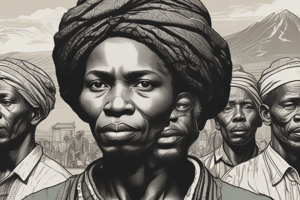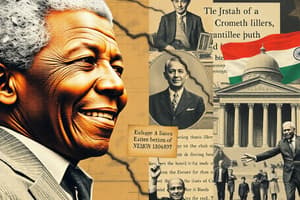Podcast
Questions and Answers
What are human rights?
What are human rights?
Rights that every person is entitled to as a human being, which cannot be taken away.
What was apartheid based on?
What was apartheid based on?
False ideas of the inferiority of different race groups.
Which of the following was a law related to racial segregation before apartheid?
Which of the following was a law related to racial segregation before apartheid?
- Pass Laws
- Native Land Act
- Coloured Bar Act
- All of the above (correct)
Who was the Prime Minister of South Africa from 1948 supporting the apartheid system?
Who was the Prime Minister of South Africa from 1948 supporting the apartheid system?
The ____________ Act of 1949 prohibited mixed marriages.
The ____________ Act of 1949 prohibited mixed marriages.
What does segregation refer to?
What does segregation refer to?
The Group Areas Act aimed to promote racial integration.
The Group Areas Act aimed to promote racial integration.
Flashcards are hidden until you start studying
Study Notes
Turning Points in Modern South African History since 1948 (Apartheid Period)
- Human Rights: Every person is entitled to fundamental rights that cannot be taken away.
- Apartheid's False Premise: It was built on the flawed notion that certain racial groups were inherently inferior, creating categories of: white, Indians, Coloureds, and blacks.
- Early Segregation (Pre-1948):
- Pass Laws: Prohibited black people from residing in urban areas.
- Wage Inequality: Black workers received lower wages than their white counterparts.
- Land Restrictions: The Native Land Act (1913) limited black ownership of land.
- Townships: Black residents in urban areas were confined to designated townships.
- Union Suppression: Black workers were denied the right to form trade unions.
- Coloured Bar Act: Skilled and semi-skilled black workers were excluded from the voters' roll.
- The National Party's Role:
- They supported the apartheid system, arguing it would resolve racial tensions.
- D.F. Malan became Prime Minister in 1948.
- Hendrick Verwoerd (architect of apartheid) drafted numerous discriminatory laws.
- Key Apartheid Laws:
- Prohibition of Mixed Marriages Act (1949): Outlawed marriage between people of different racial groups.
- Immorality Amendment Act (1950): Criminalized sexual relationships between different races.
- Population Registration Act (1950): Classified individuals by race and created racial categories.
- Group Areas Act (1950): Mandated segregation of residential areas based on race.
- Suppression of Communism Act (1950): Used to silence opposition to apartheid.
- Native Abolition of Passes and Co-ordination of Documents Act (1952): Required black people to carry passes for movement and identification.
- Separate Amenities Act (1953): Established separate facilities for different races in public spaces.
- Bantu Education Act (1953): Established a segregated and inferior education system for black children.
- Bantu Self-Government Act (1959): Intended to create racially segregated self-governing territories for black communities.
- Apartheid's Nature: A system of enforced racial segregation encompassing economic, social, political, and geographical aspects. It was rooted in the belief of white superiority.
- Segregation: The separation of people based on racial classifications.
- Trade Unions: Organizations that protect workers' rights and promote worker welfare within the workplace.
Studying That Suits You
Use AI to generate personalized quizzes and flashcards to suit your learning preferences.




